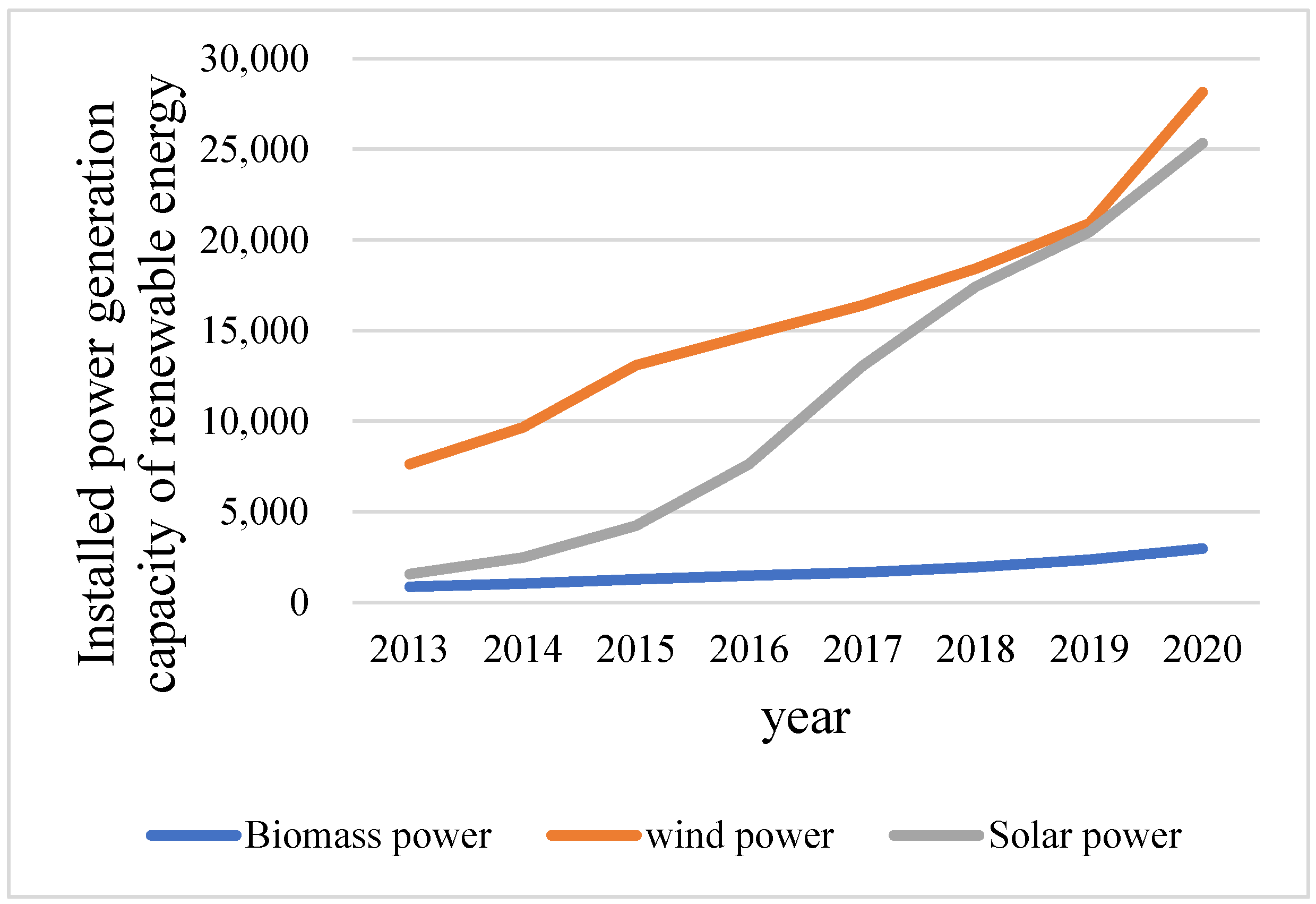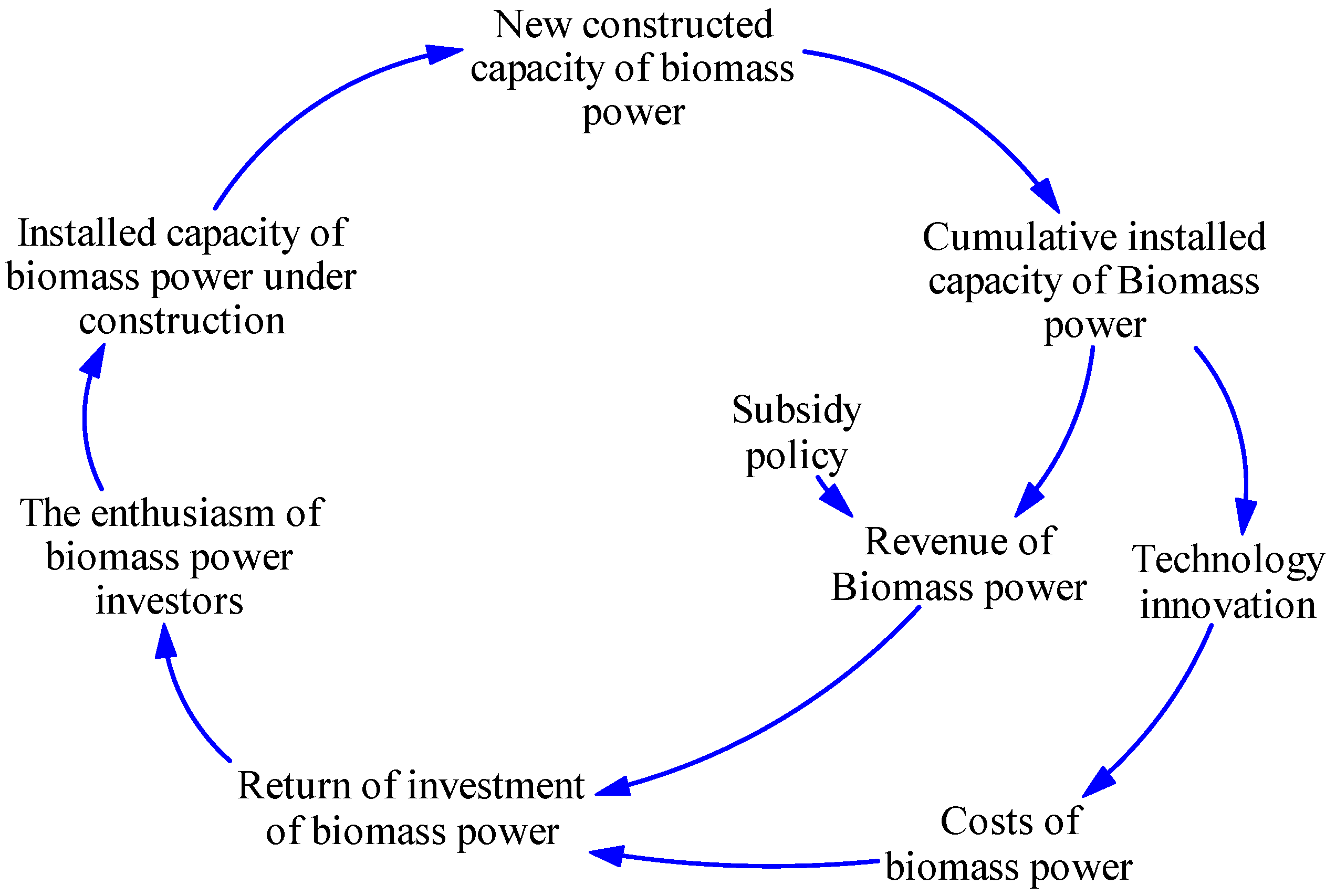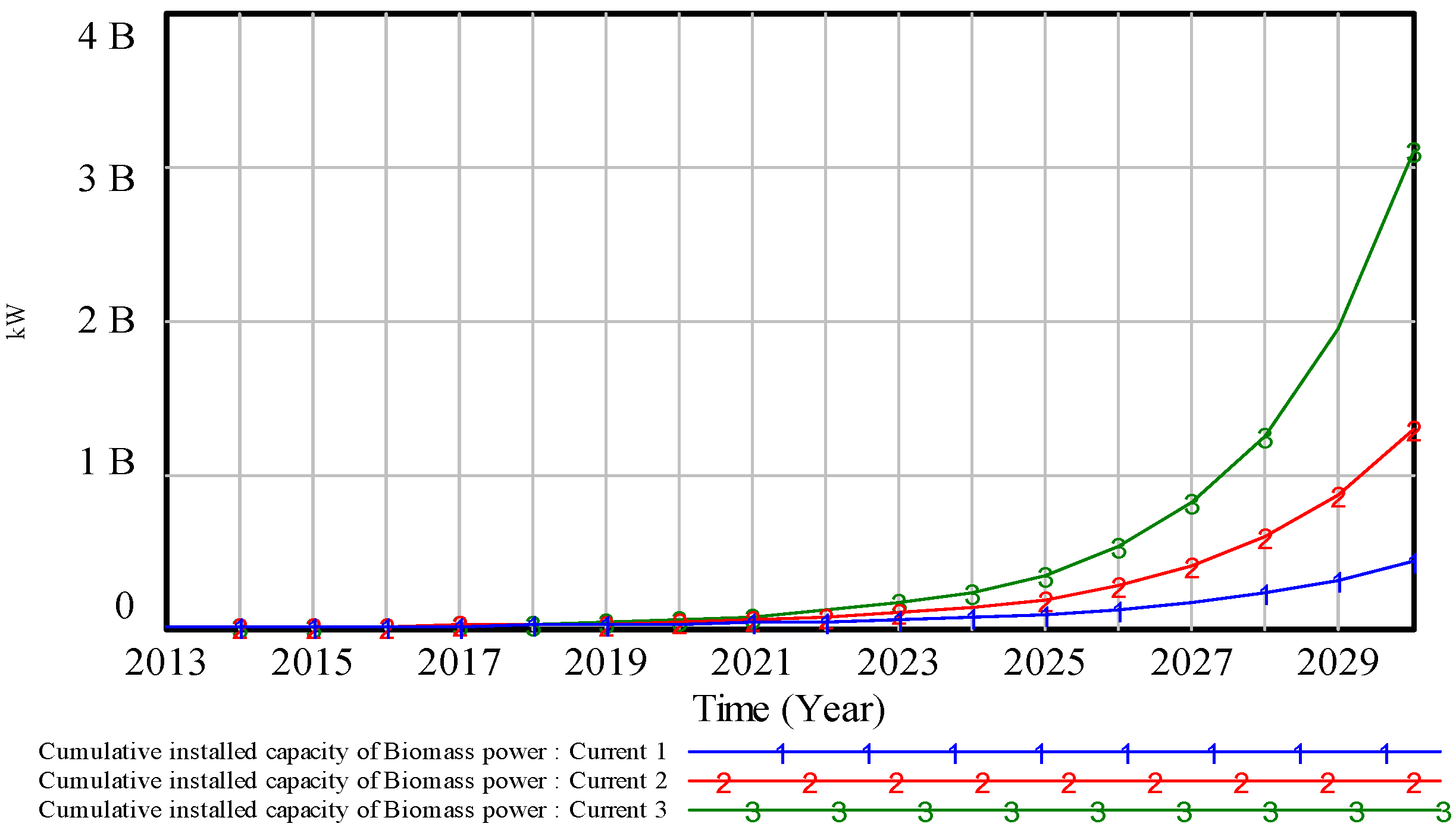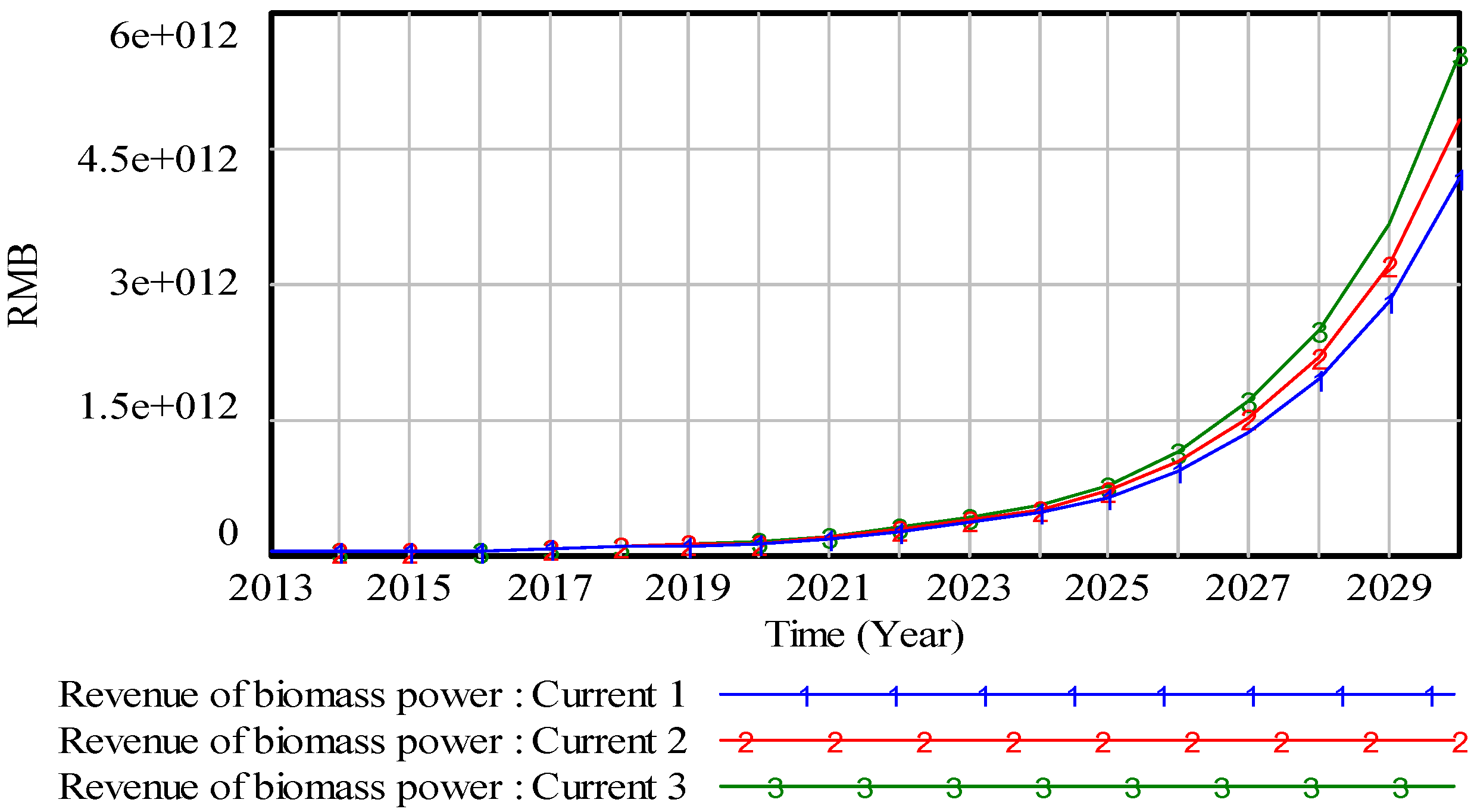Impacts of Government Policies on the Adoption of Biomass Power: A System Dynamic Perspective
Abstract
1. Introduction
1.1. Background and Motivation
1.2. Literature Reviews
1.3. Contributions and Innovations
- (1)
- The existing literature analyzed the technical and economic problems of the biomass power generation industry [19]; however, the problem of the diffusion of the biomass power industry from the perspective of technology adoption is lacking. Thus, this paper studies the adoption behavior of biomass power from the perspective of technology diffusion. At the same time, the related factors affecting the diffusion of biomass power technology are dynamically analyzed in order to clarify the diffusion mechanism.
- (2)
- In order to understand the influence of policy effects on the diffusion of biomass power projects, this paper constructs a system dynamics model to explore the influence of the interaction of the influencing factors on the diffusion, to provide support for investors’ decisions.
2. Materials and Methods
2.1. Reasons for System Dynamic Model
2.2. Model Construction
2.2.1. Model Description
2.2.2. Mathematical Model
- (1)
- Installed capacity of biomass power projects
- (2)
- Revenue composition of biomass power projects
- (3)
- Cost composition of biomass power projects
3. Results
- (1)
- Effect of different subsidy levels on installed capacity
- (2)
- Effect of different carbon price levels on installed capacity
4. Discussion
5. Conclusions
Supplementary Materials
Author Contributions
Funding
Institutional Review Board Statement
Informed Consent Statement
Data Availability Statement
Acknowledgments
Conflicts of Interest
References
- Zhang, M.; Zhou, D.; Ding, H.; Jin, J. Biomass power generation investment in China: A real options evaluation. Sustainability 2016, 8, 563. [Google Scholar] [CrossRef]
- Li, Y.; Lin, J.; Qian, Y.; Li, D. Feed-in tariff policy for biomass power generation: Incorporating the feedstock acquisition process. Eur. J. Oper. Res. 2023, 304, 1113–1132. [Google Scholar] [CrossRef]
- He, J.X. The Efficiency and Prospect of Biomass Power Development in China. Ph.D. Thesis, Xiamen University, Xiamen, China, 2019. (In Chinese). [Google Scholar]
- He, J.; Zhu, R.; Lin, B. Prospects, obstacles and solutions of biomass power industry in China. J. Clean. Prod. 2019, 237, 117783. [Google Scholar] [CrossRef]
- Guan, Y.; Tai, L.; Cheng, Z.; Chen, G.; Yan, B. Biomass molded fuel in China: Current status, policies and suggestions. Sci. Total Environ. 2020, 724, 138345. [Google Scholar] [CrossRef]
- Lin, B.; He, J. Is biomass power a good choice for governments in China? Renew. Sustain. Energy Rev. 2017, 73, 1218–1230. [Google Scholar] [CrossRef]
- Liu, J.; Wang, S.; Wei, Q.; Yan, S. Present situation, problems and solutions of China’s biomass power generation industry. Energy Policy 2014, 70, 144–151. [Google Scholar] [CrossRef]
- Zhao, Z.Y.; Yan, H. Assessment of the biomass power generation industry in China. Renew. Energy 2012, 37, 53–60. [Google Scholar] [CrossRef]
- Lin, B.; He, J. Learning curves for harnessing biomass power: What could explain the reduction of its cost during the expansion of China? Renew. Energy 2016, 99, 280–288. [Google Scholar] [CrossRef]
- Nevzorova, T.; Karakaya, E. Explaining the drivers of technological innovation systems: The case of biogas technologies in mature markets. J. Clean. Prod. 2020, 259, 120819. [Google Scholar] [CrossRef]
- Zhang, Q.; Zhou, D.; Zhou, P.; Ding, H. Cost analysis of straw-based power generation in Jiangsu Province, China. Appl. Energy 2013, 102, 785–793. [Google Scholar] [CrossRef]
- Irfan, M.; Zhao, Z.-Y.; Panjwani, M.K.; Mangi, F.H.; Li, H.; Jan, A.; Ahmad, M.; Rehman, A. Assessing the energy dynamics of Pakistan: Prospects of biomass energy. Energy Rep. 2020, 6, 80–93. [Google Scholar] [CrossRef]
- Borges, C.P.; Sobczak, J.C.; Silberg, T.R.; Uriona-Maldonado, M.; Vaz, C.R. A systems modeling approach to estimate biogas potential from biomass sources in Brazil. Renew. Sustain. Energy Rev. 2021, 138, 110518. [Google Scholar] [CrossRef]
- Yu-Zhuo, Z.; Xin-Gang, Z.; Ling-Zhi, R.; Ji, L.; Ping-Kuo, L. The development of China’s biomass power industry under feed-in tariff and renewable portfolio standard: A system dynamics analysis. Energy 2017, 139, 947–961. [Google Scholar] [CrossRef]
- Dinica, V. Support systems for the diffusion of renewable energy technologies—An investor perspective. Energy Policy 2006, 34, 461–480. [Google Scholar] [CrossRef]
- Wang, X.; Cai, Y.; Dai, C. Evaluating China’s biomass power production investment based on a policy benefit real options model. Energy 2014, 73, 751–761. [Google Scholar] [CrossRef]
- Liu, D.; Liu, M.; Xiao, B.; Guo, X.; Niu, D.; Qin, G.; Jia, H. Exploring biomass power generation’s development under encouraged policies in China. J. Clean. Prod. 2020, 258, 120786. [Google Scholar] [CrossRef]
- Hiloidhari, M.; Baruah, D.C.; Kumari, M.; Kumari, S.; Thakur, I.S. Prospect and potential of biomass power to mitigate climate change: A case study in India. J. Clean. Prod. 2019, 220, 931–944. [Google Scholar] [CrossRef]
- He, J.; Liu, Y.; Lin, B. Should China support the development of biomass power generation? Energy 2018, 163, 416–425. [Google Scholar] [CrossRef]
- Improve the Implementation Plan of Biomass Power Generation Project Construction and Operation. 2020. Available online: http://www.gov.cn/zhengce/zhengceku/2020-09/16/content_5543821.htm (accessed on 1 October 2022).
- Forrester, J.W. Counterintuitive behavior of social systems. Theory Decis. 1971, 2, 109–140. [Google Scholar] [CrossRef]
- Selvakkumaran, S.; Ahlgren, E.O. Review of the use of system dynamics (SD) in scrutinizing local energy transitions. J. Environ. Manag. 2020, 272, 111053. [Google Scholar] [CrossRef]
- Zhang, L.; Chen, C.; Wang, Q.; Zhou, D. The impact of feed-in tariff reduction and renewable portfolio standard on the development of distributed photovoltaic generation in China. Energy 2021, 232, 120933. [Google Scholar] [CrossRef]
- Yu, X.; Ge, S.; Zhou, D.; Wang, Q.; Chang, C.T.; Sang, X. Whether feed-in tariff can be effectively replaced or not? An integrated analysis of renewable portfolio standards and green certificate trading. Energy 2022, 245, 123241. [Google Scholar] [CrossRef]
- She, Z.Y.; Cao, R.; Xie, B.C.; Ma, J.J.; Lan, S. An analysis of the wind power development factors by Generalized Bass Model: A case study of China’s eight bases. J. Clean. Prod. 2019, 231, 1503–1514. [Google Scholar] [CrossRef]
- Lu, Z.Y.; Li, W.H.; Xie, B.C.; Shang, L.F. Study on China’s wind power development path—Based on the target for 2030. Renew. Sustain. Energy Rev. 2015, 51, 197–208. [Google Scholar] [CrossRef]
- Ahmad, S.; Tahar, R.M.; Muhammad-Sukki, F.; Munir, A.B.; Rahim, R.A. Role of feed-in tariff policy in promoting solar photovoltaic investments in Malaysia: A system dynamics approach. Energy 2015, 84, 808–815. [Google Scholar] [CrossRef]
- Wright, T.P. Factors affecting the cost of airplanes. J. Aeronaut. Sci. 1936, 3, 122–128. [Google Scholar] [CrossRef]
- Zhang, M.; Tang, Y.; Liu, L.; Zhou, D. Optimal investment portfolio strategies for power enterprises under multi-policy scenarios of renewable energy. Renew. Sustain. Energy Rev. 2022, 154, 111879. [Google Scholar] [CrossRef]
- Wene, C.O. Experience Curves for Energy Technology Policy; International Energy Agency (IEA): Paris, France, 2000. [Google Scholar]
- Junginger, M.; Faaij, A.; Björheden, R.; Turkenburg, W. Technological learning and cost reductions in wood fuel supply chains in Sweden. Biomass Bioenergy 2005, 29, 399–418. [Google Scholar] [CrossRef]






Disclaimer/Publisher’s Note: The statements, opinions and data contained in all publications are solely those of the individual author(s) and contributor(s) and not of MDPI and/or the editor(s). MDPI and/or the editor(s) disclaim responsibility for any injury to people or property resulting from any ideas, methods, instructions or products referred to in the content. |
© 2023 by the authors. Licensee MDPI, Basel, Switzerland. This article is an open access article distributed under the terms and conditions of the Creative Commons Attribution (CC BY) license (https://creativecommons.org/licenses/by/4.0/).
Share and Cite
Xin-gang, Z.; Wei, W.; Shuran, H.; Xuan, L. Impacts of Government Policies on the Adoption of Biomass Power: A System Dynamic Perspective. Sustainability 2023, 15, 1723. https://doi.org/10.3390/su15021723
Xin-gang Z, Wei W, Shuran H, Xuan L. Impacts of Government Policies on the Adoption of Biomass Power: A System Dynamic Perspective. Sustainability. 2023; 15(2):1723. https://doi.org/10.3390/su15021723
Chicago/Turabian StyleXin-gang, Zhao, Wang Wei, Hu Shuran, and Liu Xuan. 2023. "Impacts of Government Policies on the Adoption of Biomass Power: A System Dynamic Perspective" Sustainability 15, no. 2: 1723. https://doi.org/10.3390/su15021723
APA StyleXin-gang, Z., Wei, W., Shuran, H., & Xuan, L. (2023). Impacts of Government Policies on the Adoption of Biomass Power: A System Dynamic Perspective. Sustainability, 15(2), 1723. https://doi.org/10.3390/su15021723









